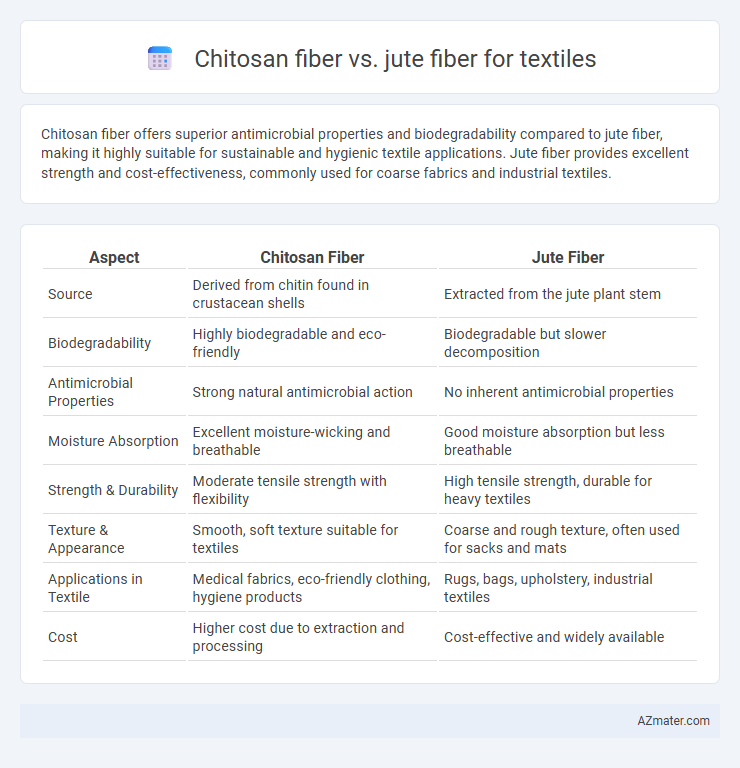Chitosan fiber offers superior antimicrobial properties and biodegradability compared to jute fiber, making it highly suitable for sustainable and hygienic textile applications. Jute fiber provides excellent strength and cost-effectiveness, commonly used for coarse fabrics and industrial textiles.
Table of Comparison
| Aspect | Chitosan Fiber | Jute Fiber |
|---|---|---|
| Source | Derived from chitin found in crustacean shells | Extracted from the jute plant stem |
| Biodegradability | Highly biodegradable and eco-friendly | Biodegradable but slower decomposition |
| Antimicrobial Properties | Strong natural antimicrobial action | No inherent antimicrobial properties |
| Moisture Absorption | Excellent moisture-wicking and breathable | Good moisture absorption but less breathable |
| Strength & Durability | Moderate tensile strength with flexibility | High tensile strength, durable for heavy textiles |
| Texture & Appearance | Smooth, soft texture suitable for textiles | Coarse and rough texture, often used for sacks and mats |
| Applications in Textile | Medical fabrics, eco-friendly clothing, hygiene products | Rugs, bags, upholstery, industrial textiles |
| Cost | Higher cost due to extraction and processing | Cost-effective and widely available |
Introduction: Chitosan Fiber vs Jute Fiber in Textiles
Chitosan fiber, derived from chitin found in crustacean shells, offers antimicrobial properties and biodegradability, making it a sustainable alternative in textile applications. Jute fiber, extracted from the Corchorus plant, is known for its strength, affordability, and eco-friendliness, commonly used in coarse textiles and packaging. Comparing both, chitosan fiber excels in functional textile uses due to its bioactive features, while jute remains preferred for traditional, durable fabric production.
Origin and Source: Chitosan and Jute Fibers
Chitosan fiber is derived from chitin, a natural biopolymer extracted primarily from the exoskeletons of crustaceans such as shrimp and crabs, making it a marine-origin fiber with inherent biodegradability and antimicrobial properties. Jute fiber originates from the bast of the Corchorus plant, predominantly cultivated in India and Bangladesh, valued for its eco-friendly, renewable, and coarse natural fiber characteristics suited for textile and industrial applications. The distinct biological sources impact their sustainability profiles and functional uses in textile manufacturing, with chitosan providing advanced bio-functional benefits and jute offering affordability and traditional fiber utility.
Chemical Structure and Composition Comparison
Chitosan fiber is primarily composed of b-(1-4)-linked D-glucosamine units derived from chitin, featuring abundant amino groups that confer antimicrobial properties and enhance dye affinity. In contrast, jute fiber consists mainly of cellulose polymers with b-(1-4)-linked D-glucose units, which provide rigidity but lack inherent bioactivity. The presence of reactive amine groups in chitosan fibers results in superior functional properties compared to the mostly cellulose-based and lignin-containing structure of jute fibers.
Fiber Processing and Manufacturing Techniques
Chitosan fiber production involves the dissolution of chitosan extracted from crustacean shells, followed by wet spinning to form fine, antimicrobial filaments ideal for textile applications. Jute fiber processing relies on retting to separate fibers from the stalks, followed by carding and spinning into coarse yarns commonly used for durable, eco-friendly textiles. Manufacturing chitosan fibers requires biochemical treatment and precise control of spinning parameters, whereas jute fiber production emphasizes mechanical extraction and traditional spinning techniques.
Mechanical Properties: Strength, Durability, and Flexibility
Chitosan fiber exhibits superior tensile strength and enhanced durability compared to jute fiber, making it ideal for high-performance textile applications. Its natural antimicrobial properties also contribute to extended fabric life, while maintaining excellent flexibility and comfort. Jute fibers, although renewable and cost-effective, generally demonstrate lower mechanical strength and are more prone to wear and tear under repetitive stress.
Biodegradability and Environmental Impact
Chitosan fiber exhibits superior biodegradability compared to jute fiber due to its natural origin from chitin, which decomposes rapidly without releasing harmful residues. While jute fiber is also biodegradable and environmentally friendly, it requires more water and land resources during cultivation, resulting in a higher ecological footprint. Chitosan fiber's antimicrobial properties further reduce the need for chemical treatments, enhancing its overall environmental sustainability in textile applications.
Moisture Absorption and Breathability
Chitosan fiber exhibits superior moisture absorption capabilities compared to jute fiber, effectively wicking sweat away from the skin to maintain dryness and comfort. Its inherent antimicrobial properties further enhance breathability by reducing bacterial growth, making it ideal for high-performance textiles. In contrast, jute fiber, while breathable, has lower moisture retention and dries slower, which may impact comfort in humid conditions.
Applications in Textile Industry
Chitosan fibers exhibit excellent antimicrobial properties and biodegradability, making them highly suitable for medical textiles, sportswear, and protective clothing in the textile industry. Jute fibers are widely used for eco-friendly bags, upholstery, and home decor due to their durability, high tensile strength, and cost-effectiveness. Both fibers contribute to sustainable textile applications, with chitosan adding functional benefits and jute providing robust structural qualities.
Cost-Effectiveness and Market Availability
Chitosan fiber offers superior antimicrobial properties and biodegradability but remains costlier due to limited large-scale production compared to jute fiber, which is widely available and economically favorable for textile applications. Jute fiber, sourced abundantly from regions like India and Bangladesh, dominates the market with low production costs and established supply chains, making it a cost-effective option for bulk textile manufacturing. Despite its higher price, chitosan fiber's functional benefits justify investment in niche markets emphasizing sustainability and performance.
Future Prospects and Innovations in Textile Fibers
Chitosan fiber offers superior antimicrobial properties and biodegradability compared to traditional jute fiber, making it a promising candidate for advanced textile applications. Innovations in nanotechnology and bioengineering are enhancing chitosan fiber's mechanical strength and moisture management, positioning it as a sustainable alternative for smart textiles and medical fabrics. Future prospects highlight chitosan fiber's potential to revolutionize eco-friendly textile production by integrating functionality with environmental responsibility.

Infographic: Chitosan fiber vs Jute fiber for Textile
 azmater.com
azmater.com